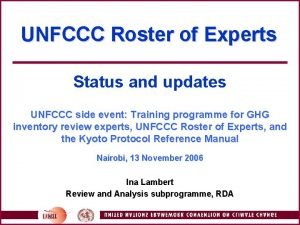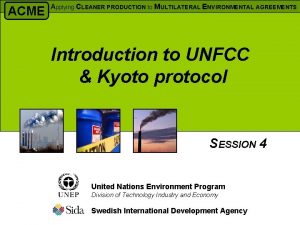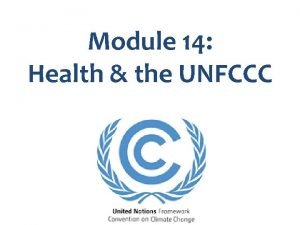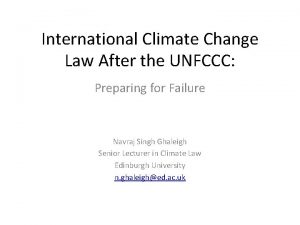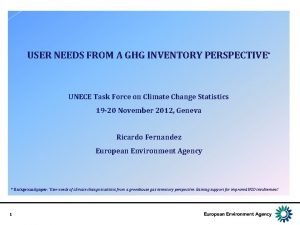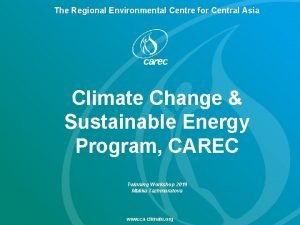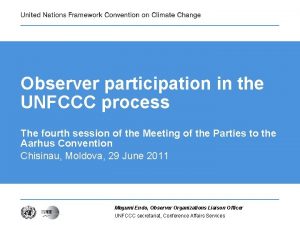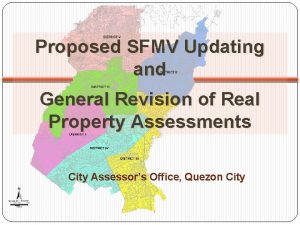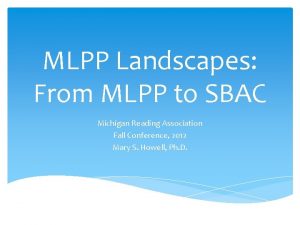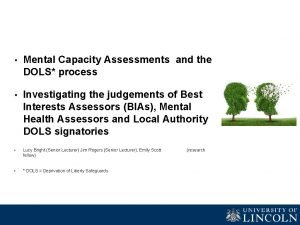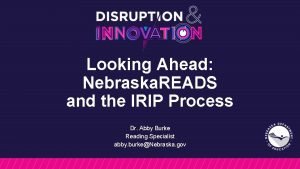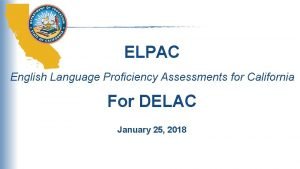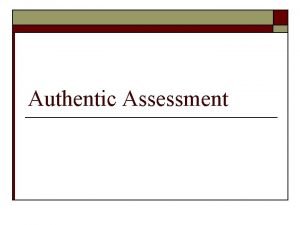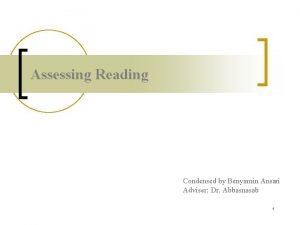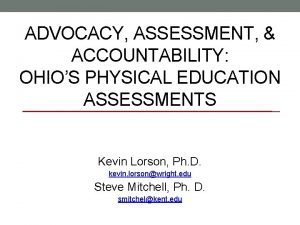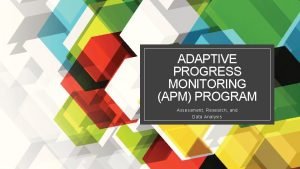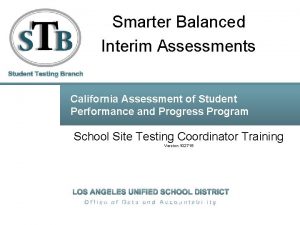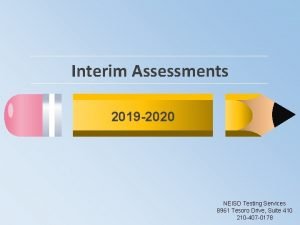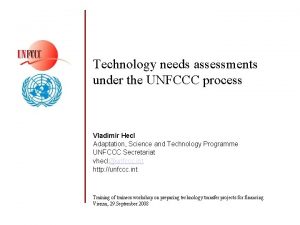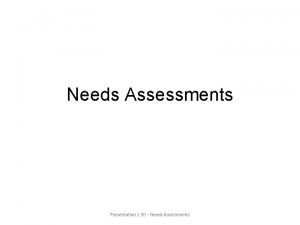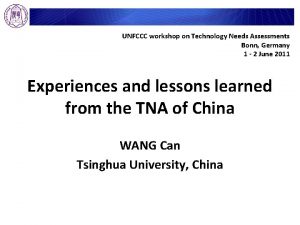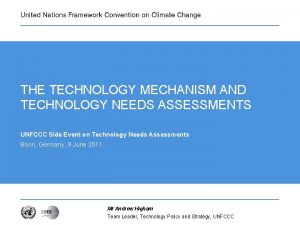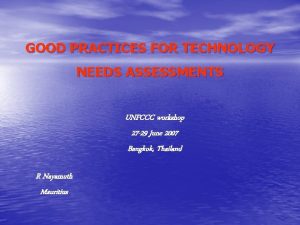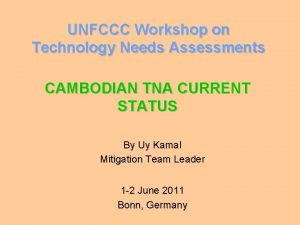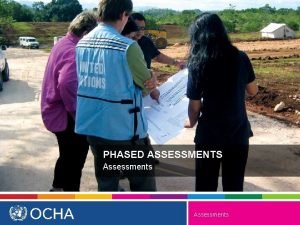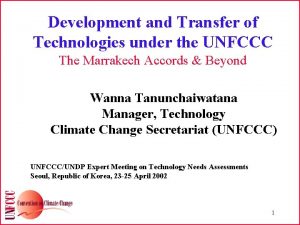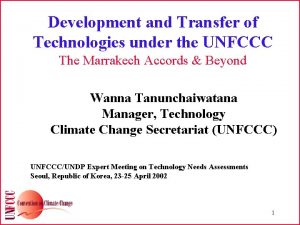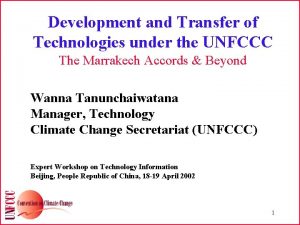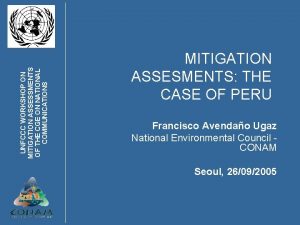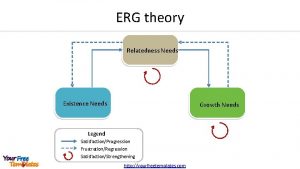Technologies needs assessments under the UNFCCC process Iulian




































- Slides: 36

Technologies needs assessments under the UNFCCC process Iulian Florin Vladu Technology Sub-programme Adaptation, Technology and Science Programme UNFCCC July 2007 Bangkok, Thailand 1

This presentation will cover: o Technology framework and its thematic area on technology needs and needs assessment o TNAs – definition and purpose o Priority technology needs of non-Annex I Parties o Opportunities for implementing the findings of TNAs o Issues for consideration Iulian Florin VLADU - Technology Subprogramme 2

Major milestones for the technology process Iulian Florin VLADU - Technology Subprogramme 3

Integrated vision | Technology, policy and investment PPP - Identify technology needs - Enhance access to technology information - Improve technology absorption capacity - Assess technologies for adaptation concentrating - Collaborative CCS in power sector. Biodiesel, (CCS R&D Energy‑efficiency (e. g. vehicle fuel solar power, IGCC, fuel cells, Endogenous technologies advanced steam cycle. Public with economy improvements, motor and steam Private CCS advanced steam cycle oxyfueling, CCS-IGCC), systems, buildings and appliances), with flue-gas separation hydrogen fuel cell vehicles, renewable energy and reducing gas flaring Economic incentives (e. g. adoption subsidies, Public Private Partnerships ocean energy- Enabling and fusion environments for technology transfer Publicly funded R&D, R&D direct public sector investments and carbon Subsidies and grants tax credits markets) - Market creation and transformation Governments contracts & specialized programs - Regulatory approaches (e. g. emission taxes, renewable portfolio standards) Concessional loans & seed capital - Legislative frameworks, and codes, labels and Entrepreneur’s equity(technology, performance) standards -Options for innovative financing of technology transfer Supplier credits & Build-Own-Transfer - private financing advisory network - EU - GEEREF Corporate finance & project finance - new multilateral technology cooperation fund Third party financing Investment insurance & guarantees Bank loans Iulian Florin VLADU - Technology Subprogramme 4

TNAs | What are they? o The technology transfer framework defines TNAs as a set of country-driven activities that identify and determine the mitigation and adaptation technology priorities of Parties, …, particularly developing country Parties o They involve different stakeholders in a consultative process to identify the barriers to technology transfer and measures to address these barriers through sectoral analyses o These activities may address soft and hard technologies, such as mitigation and adaptation technologies, identify regulatory options and develop fiscal and financial incentives and capacity building Iulian Florin VLADU - Technology Subprogramme 5

TNAs | What are they? The purpose of TNAs is to assist in identifying and analysing priority technology needs, which can form the basis for a portfolio of EST projects and programmes which can facilitate the transfer of, and access to, the ESTs and know-how in the implementation of Article 4, paragraph 5, of the Convention o TNAs are central to the work on technology transfer. They follow a country-driven approach, bringing together stakeholders to identify needs and develop plans to meet those needs o Iulian Florin VLADU - Technology Subprogramme 6

TNAs | Support, methodology and guidance o GEF has provided funding to 94 non-Annex I Parties to conduct TNAs through its interim financing for capacity-building in priority areas – enabling activities phase II (also known as “top-ups”). 80 are being supported by UNDP and 14 by the UNEP. Some 34 TNA reports are available o 1 expert meeting to identify methodologies to conduct TNAs UNDP developed a simplified, user-friendly handbook on Conducting TNAs for climate change The TNA handbook, produced in collaboration with CTI, the EGTT and the secretariat, was made available to Parties in 2004 o CTI, in collaboration with UNDP, organized 3 regional workshops to field-test and further develop the TNA handbook, to discuss regional concerns and priorities in assessing technology needs and to further assist Parties in conducting TNAs Iulian Florin VLADU - Technology Subprogramme 7

Input from NC, NAPAs, national development plans Mitigation Adaptation Activity 1: Prepare a preliminary overview of the sectors Review GHG inventory for mitigation potential Review national plans in identified sectors Identify key sectors and characteristics Review available vulnerability studies Identify vulnerable sectors Review national plans in vulnerable sectors Activity 2: Identify technology criteria for assessment Prepare list of sectors with mitigation potential Develop criteria to apply to vulnerable sectors Activity 3: Prioritize sectors and select key technology( ies) Compile a list of prioritized mitigation technologies and key sectors Identify characteristics of prioritized sectors Prioritize vulnerable sectors Compile responses to address vulnerability Activity 4: Identify barriers and policy needs* Conduct environmental technology impact assessment Assess capacity to use mitigation technologies Conduct environmental technology impact assessment Assess capacity to use adaptation technologies Cross-cutting issues (Stakeholder engagement and barrier analysis) Review technology options and resources Activity 5: Define and select options Rank and select prioritized mitigation technologies and key sectors Output to NC, NAPAs national development plans Identify practical options for priority sectors Identify responses and technologies Rank and prioritize applicable technologies Activity 6: Prepare a synthesis report Summary report in NC Full report (including a description of the stakeholder process adopted, an evaluation of sectoral needs and opportunities…, a statement of data gaps, project concepts/proposals, potential sources of funding) Communicate TNA findings Implementation actions Assess adequacy of financial resources Ensure transparency Identify potential synergies Identify ways to reduce barriers Continue stakeholder involvement Revise plans as needed Iulian Florin VLADU - Technology Subprogramme 8

TNAs | A simplified view of the needs assessments process Forming institution arrangements Identify relevant stakeholders; consult key agencies Convene meeting to explore objectives and scope Establish the team ~ lead agency ~ lead technical institution ~ other players Define process for ongoing involvement of all stakeholders Needs assessments process Preparing & implementing technology transfer actions & plans Establish criteria for selecting technology transfer priorities Define priority sectors and sub-sectors Securing resources Development of implementation strategies Compile and supplement technology and market information Select priority technologies Integration with existing development programs Preparation of technology transfer plans Further technology & barrier assessment & stakeholder consultations Define alternative actions Implementation of technology transfer actions Ongoing review and refinement of actions Select actions Prepare needs assessment report Iulian Florin VLADU - Technology Subprogramme 9

TNAs | What are the priority technology needs? o Synthesis of technology needs assessments (TNAs) – FCCC/SBSTA/2006/INF. 1: Ø Highlights priority technology needs to reduce greenhouse gas emissions and facilitate adaptation to the adverse impacts of climate change based on information contained in 23 TNAs and 25 initial national communications submitted by non. Annex I Parties Ø Draws attention to specific barriers to technology transfer and suggests measures to address them, including through capacity-building Ø Highlights ways used to involve stakeholders in a consultative process to conduct TNAs, including the methodologies and criteria used to prioritize technology needs Iulian Florin VLADU - Technology Subprogramme 10

TNAs | How representative are their results? Iulian Florin VLADU - Technology Subprogramme 11

TNAs - how priorities were selected? | How they relate to national development objectives? Iulian Florin VLADU - Technology Subprogramme 12

TNAs | What are commonly identified mitigation technologies in TNAs? Iulian Florin VLADU - Technology Subprogramme 13

TNAs | What are commonly identified renewable energy technology needs? Iulian Florin VLADU - Technology Subprogramme 14

TNAS | What are commonly identified energy efficient technology needs (buildings & residential)? Iulian Florin VLADU - Technology Subprogramme 15

TNAs | What are commonly identified adaptation technologies in TNAs? Iulian Florin VLADU - Technology Subprogramme 16

TNAs | What are commonly identified technologies to address sea-level rise? Iulian Florin VLADU - Technology Subprogramme 17

TNAs | What are main barriers to technology transfer identified by country? Iulian Florin VLADU - Technology Subprogramme 18

TNAs | What are main measures to address barriers to technology transfer? Iulian Florin VLADU - Technology Subprogramme 19

TNAs | What are main capacity-building needs? Iulian Florin VLADU - Technology Subprogramme 20

TNAs synthesis report | key findings o The TNA is an effective tool for decision makers and international institutions that may be involved in the facilitation of the technology transfer process. The TNA process not only helps identify specific technology needs, but also points out the direction in which future policies and regulations will need to progress o The main beneficiary of the TNAs are the Parties that conducted them, as these reports provide a good basis for follow-up activities to further enhance the transfer of climate friendly technologies. Iulian Florin VLADU - Technology Subprogramme 21

Implementing TNAs | What are main opportunities for financing the implementation of TNA findings? • Trust Fund • SCCF • LDCF Adaptation Fund FINANCIAL MECHANISM (GEF) CDM/JI BILATERAL • ODA (OECD/DAC) • Seed financing • Green Financing Convention and KP MULTILATERAL • UNEP, UNDP, UNCTAD • World Bank Carbon Finance, CEFV, CESF • IFC, EBRD • EU COMMISSION (FP) PPPs Export Credit Agencies PRIVATE SECTOR • Commercial banks • Micro financing • Insurances Iulian Florin VLADU - Technology Subprogramme 22

Implementing | What is financed under the GEF? o The GEF trust fund allocates and disburses about USD 250 million dollars per year in projects in energy efficiency, renewable energies, and sustainable transportation o The current strategy focuses on market transformation, policy and structural changes, and in addressing market failures o Special Climate Change Fund - mainly through technology programmes that seek to building capacity for applying specific technologies (~USD 6 m). Iulian Florin VLADU - Technology Subprogramme 23

Implementing | What are main opportunities for financing technology transfer projects under CDM? o Project pipeline > 1, 600 projects Ø 565 registered; 121 million CERs/year; 51% large and 49% small scale Ø 105 requesting registration: 22 million CERs/year o Two recent studies : Ø Technology transfer by CDM projects, 2006, E. Haites Ø Technology transfer in the CDM, 2006, ECN, H. C. de Coninck o Roughly one-third of all CDM projects accounting for almost two-thirds of the annual emission reductions involve technology transfer Iulian Florin VLADU - Technology Subprogramme 24

Financing | What are main opportunities for financing technology transfer projects under CDM? o Technology tends to play an important role - projects either scale-up the deployment of technology solutions already available in the host country or introduce technological solutions from other countries o Evident from the methodologies applied so far, which tend to involve a change in technology rather than change in management or policy Iulian Florin VLADU - Technology Subprogramme 25

Financing | What are main opportunities for financing technology transfer projects under CDM? 854 projects Average project size 175 kt. CO 2 e/yr 68% unilateral 47% small-scale Source: Technology transfer by CDM projects, 2006, E. Haites Iulian Florin VLADU - Technology Subprogramme 26

Financing | What are main opportunities for financing technology transfer projects under CDM? Source: Technology transfer by CDM projects, 2006, E. Haites Iulian Florin VLADU - Technology Subprogramme 27

Implementing | What are main opportunities for financing technology transfer projects under ODA? o DAC members provided some USD 2. 8 billions per year in average through their climate change related bilateral aid Climate change-related aid by income group and by region, commitments 1998 -2004 Breakdown by income group Breakdown by region Source: data are derived from the OECD Creditor Reporting System database and do not include multilateral contributions to organizations active in the field of climate change Iulian Florin VLADU - Technology Subprogramme 28

Financing | What are main opportunities for financing technology transfer projects under ODA? o The DAC data indicate that most of support went into energy and transport sectors. A detailed analysis is nevertheless needed to identify to what extents these flows were used for technology transfer and what were the technologies that received support Climate change-related aid by sector commitments 1998 -2004 1998 -2000 2001 -2004 Iulian Florin VLADU - Technology Subprogramme 29

Implementing | What opportunities exists for multilateral financing of technology transfer projects? o The World Bank Group has launched a series of carbon funds to demonstrate how to achieve cost-effective GHG reductions while contributing to sustainable development. Ø The World Bank Investment Framework for Clean Energy and Development aims to provide extensive support for mitigation and adaptation projects Ø The new financial instruments being considered are a Clean Energy Financing Vehicle, which would blend public and private sources of financing to promote low carbon technologies, and a Clean Energy Support Fund, which would provide subsidies in line with the extent of carbon emission reductions o The UNDP is establishing its Millennium Development Goal (MDG) Carbon Facility, a carbon-finance mechanism featuring emission offsets derived from projects that contribute directly to achieving the MDGs. Under this facility, UNDP will mobilize carbon finance and direct this towards developing a portfolio of projects that yield tangible sustainable development and poverty reduction benefits across a diverse group of developing countries Iulian Florin VLADU - Technology Subprogramme 30

Implementing | What opportunities exists for multilateral financing of technology transfer projects? o The Finance Initiative of the UNEP FI is a global partnership between UNEP and over 160 financial institutions and a range of partner organizations to develop and promote linkages between the environment, sustainability and financial performance. UNEP FI focal areas include examination of different types of financial instruments/products and services that lead to climate change mitigation and adaptation, and renewable energy. o The Global Energy Efficiency and Renewable Energy Fund of the European Commission aims to blend capital of public and private investors, and support small- and medium-size projects and enterprises. The fund recognizes that private investors need higher financial returns and that public investors value the economic, social and environmental benefits of renewable energy investments more than most private investors Iulian Florin VLADU - Technology Subprogramme 31

Implementing | What is the role of private sector investment? o Private sector investment has been recognized as a key for the success of technology transfer activities. o The level of FDI, commercial lending, and equity investment all increased greatly in recent years. For example, FDI flows to developing countries continued to grow in 2005, reaching a record level of USD 237. 5 billion Ø These are the dominant means by which the private sector makes technology-based investments in developing countries and economies in transition, often in the industry, energy supply and transportation sectors Ø It is therefore critical to ensure that the necessary conditions are in place to encourage this flow and to ensure that all countries have access to it (main beneficiaries at present are Europe & Central Asia, East Asia and the Pacific and Latin America and Caribbean). Iulian Florin VLADU - Technology Subprogramme 32

Implementing | What are innovative options? o Innovative financing options are simply new combinations or adjustments of existing instruments and resources, rather than new financial instruments aimed exclusively at addressing climate change Ø Introducing financing considerations in the project development cycle Ø Financing continuum: general financing instruments for technology transfer o 2 workshops – brought together Parties, project developers and international financial community o Technical paper on Innovative financing (FCCC/SBSTA/2006/TP 1) – an easy-to-read brochure for SB 26 Iulian Florin VLADU - Technology Subprogramme 33

Implementing | What are innovative options? o Prepare and disseminate a Practitioner's guide to support projects developers to prepare project proposals that meet the standards of financial community Ø Available in several languages; English, French, Spanish Ø A roll-out programme is under preparation (regional training workshops, learning centres, help desk) o CTI – Private Financing Advisory Network Iulian Florin VLADU - Technology Subprogramme 34

Issues for consideration o Conducting TNAs Ø Ø Ø o Reporting, synthesizing and communicating TNA findings Ø Ø Ø o Identification of good practices Enhance guidance Support countries conducting TNAs Enhance guidance for reporting Awareness rising on TNA results (national and international)) Update TNAs Implementing the findings of TNAs Ø Develop good implementation plans and project proposals Ø PFAN? Iulian Florin VLADU - Technology Subprogramme 35

THANK YOU! Fvladu@unfccc. int Iulian Florin VLADU - Technology Subprogramme 36
 Unfccc roster of experts
Unfccc roster of experts Unfccc annex 1 countries
Unfccc annex 1 countries Unfccc
Unfccc Unfccc
Unfccc Unece nuclear energy
Unece nuclear energy Unfccc 2020
Unfccc 2020 Megumi endo unfccc
Megumi endo unfccc Unfccc 2020
Unfccc 2020 Primary needs and secondary needs
Primary needs and secondary needs Primary needs and secondary needs
Primary needs and secondary needs Henry murray theory
Henry murray theory Strategic gender needs and practical gender needs
Strategic gender needs and practical gender needs Define need analysis
Define need analysis General revision of assessments and property classification
General revision of assessments and property classification Performance assessments examples
Performance assessments examples Premarital tests or assessments
Premarital tests or assessments Formative assessments in physical education
Formative assessments in physical education Strengths and weaknesses of product-oriented assessment
Strengths and weaknesses of product-oriented assessment Mlpp assessments
Mlpp assessments Six dols assessments
Six dols assessments Irip nebraska
Irip nebraska Iri reading assessment
Iri reading assessment Occupational therapy assessments for low vision
Occupational therapy assessments for low vision Celdt vs elpac
Celdt vs elpac Cte technical skills assessments.azed.gov/student
Cte technical skills assessments.azed.gov/student Creative arts grade 8 dance test
Creative arts grade 8 dance test Common core institute
Common core institute Authentic tasks meaning
Authentic tasks meaning Formal and informal assessment
Formal and informal assessment Characteristics of psychological assessment
Characteristics of psychological assessment Reading assessment examples
Reading assessment examples Ohio physical education assessments
Ohio physical education assessments Fsa assessments org apm
Fsa assessments org apm Sat suite of assessments
Sat suite of assessments Lausd interim assessments
Lausd interim assessments Staar interim assessments 2019-2020
Staar interim assessments 2019-2020 Placement, formative, diagnostic and summative assessment
Placement, formative, diagnostic and summative assessment
